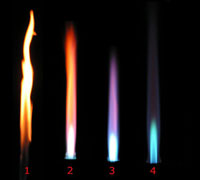Cracked Fireboxes. Causes and Solutions!
What is a firebox or what is a heat exchanger? These two different words are nomenclature meaning the thin layer of metal that separates the good air that you breathe and the bad air comes from burning natural gas in a forced air heater or burning propane in a forced air heater. When natural gas is burning, it emits carbon dioxide, water vapor, carbon monoxide, nitrogen oxides and sulfur dioxide. While carbon dioxide (CO2) and water (H2O) not harmful to us carbon monoxide (CO), nitrogen oxides(NO, NO2, etc.) and sulfur dioxide(SO2) are. During the burning process, the firebox contains these poisons and steers them towards the vent, which takes them up and out the roof safely away from you and your family. About 170 people a year die from non-automobile related carbon monoxide poisoning.
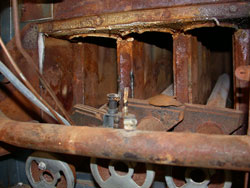
Heat exchangers corrode from the chemicals in the emissions of the burning gases. The water moisture present tends to corrode those fireboxes not protected by coating. Some manufacturers have heat exchangers that are steel coated with aluminum. This certainly slows down the rusting and gives a greater lifetime of usability to these protected fireboxes than to ordinary run of the mill tubular or stamped steel fireboxes.
The number one reason for firebox failure is age. A furnace can cycle on and off upwards of 10,000 times a year. That means that the firebox goes from dead cold (lets take a temperature of 70 degrees Fahrenheit) and is subjected to the natural gas flames which burn at 900 to 1500 degrees Fahrenheit. As the firebox heats up it warms the air on the outside of the firebox, the air that you breathe, and this triggers the fan which turns on from temperature, time or a combination of time and temperate. Most furnaces run at about 140 degrees air temperature.
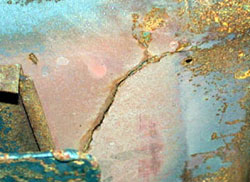
The heat exchanger is subjected to a temperature rise of about 900 degrees in minutes and does so upwards of 10,000 times year. This rapid increase in temperature subjects the metal in the box to expansion and corresponding contraction. This expansion and contraction causes metal fatigue making the heat exchanger brittle and eventually causing cracks. The crack cannot be welded or repaired. It must be replaced as any welding will simply fail because of the expansion and contraction and the brittle nature of the much worn metal of the cracked heat exchanger.
The number two reason for heat exchanger failure is rust. Older furnaces have pilot lights. If you have a forced air furnace with a pilot light, you have a very old furnace and it should be replaced because of safety concerns and efficiency. The money that you will save on your heating bill, bear in mind that the longer your furnace operates the higher your electric bill will be as well, will end up paying for the new furnace.
Those pilot lights emit the carbon monoxide, nitrogen oxides, sulfur dioxide and water vapor just like their bigger cousin the main burners. This constant supply of moisture and acidic gas eats away at the firebox just above the flame and causes a rusted through section that can allow the products of combustion into the air that you and your family breathe.
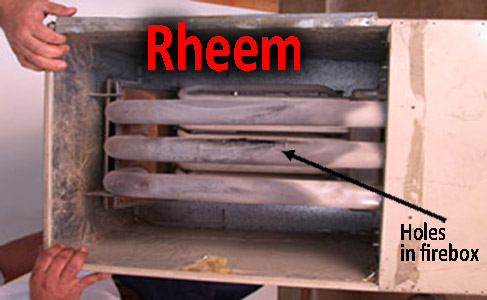
The number three reason for heat exchanger failure is defects in manufacturing. There are many things that can wrong in the manufacturing cycle. The metal of the firebox could be substandard. The flame inset pattern could have the flame touching the inner wall of the heat exchanger. The inner heat exchangers of the furnace could not be attached as well as they should have. The gas burners could be subjected to so much gas that they literarily blow apart the heat exchanger.
The number four reason for heat exchanger failure is lack of airflow across the firebox. This could be a manufacturers defect, but it is here separated because it is nearly always and installer problem. Undersized ducting slows the airflow of air across the heat exchanger and causes it run at elevated levels. These elevated temperatures or “hotter temperatures” subject the firebox to more wear and tear. It’s that expansion and contraction that wears fireboxes out.
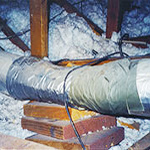
Combine the undersized ducting with a lack of maintenance. The filter gets plugged up. The evaporator coil becomes clogged with lint, dirt and debris. How about crushed ducting? All of these items are dangerous for your furnace and when you start combining them, the risks also increase. Your heat exchanger is at your mercy and because of this; you should have your furnace checked out every year.
We have gone over the reasons for heat exchanger failure:
1. Age and expansion and contraction.2. Rust and corrosion.
3. Manufacturer defects.
4. Lack of airflow, overheating.
Lets go over the effects of a heat exchanger failure. Most people tend to think that carbon monoxide is the main threat from a cracked heat exchanger. Carbon monoxide is a threat from a cracked firebox, but it is not the main threat. Carbon monoxide is merely the scary threat. Carbon monoxide is known as the “Silent Killer”. Large doses of carbon monoxide will give you flue like, nausea, headache and general tiredness. You’ll end up going to sleep thinking that you are just coming down with a cold and you never wake up. We could go over all the affects of carbon monoxide poisoning, but you can Google it and come up with lots of web sites addressing carbon monoxide.
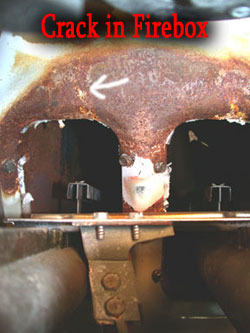
Most People Are Wrong. The number one problem with a cracked firebox is flame roll out, not carbon monoxide poisoning. The majority of furnace heat exchangers and furnace fireboxes today are designed with an induced draft motor. This motor is placed after the firebox and pulls the air through the firebox exiting into the vent through the roof.
This induced draft motor enables the firebox to operate in a negative pressure environment or vacuum. Just before the burners turn on, the induced draft motor starts and creates a vacuum in the firebox. The burners kick on and a timer starts. After so many seconds the blower motor for the furnace starts and pushes air under static pressure through the outside of the firebox. This means that the air inside the heat exchanger it is experiencing negative air pressure and outside the firebox the air is positive pressure. When a heat exchanger experiences a crack it generally will cause the greater air pressure from the larger blower motor to push air into the heat exchanger chamber causing all sorts of problems with the flame patterns. If the cracks become large enough, the air rushing through the flames will push the flames right out of the firebox and out the front of the furnace. This is the location of the gas valve, gas controls and often the thin flexible gas connector. The gas tubing prior to the gas valve does not have any safety controls that can act in the event of an emergency. If that this flexible gas connector melts or burns open, the furnace and surrounding area can become fully ablaze with very large natural gas flames. This can cause a home fire.
Special thanks to The Empire Family of Services, Plumbing, Heating, Air Conditioning and Electrical for publishing this article. If you live in the Los Angeles area please call them for your service.
If you live in the New Orleans area, call Surgi's Heating and Air Conditioning at 469-4232 for your fall furnace check. We're here to help.

